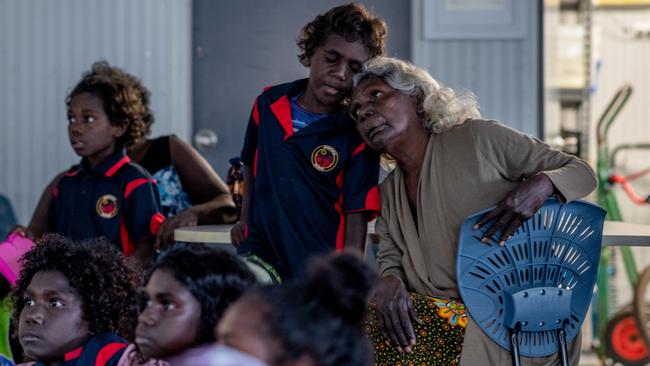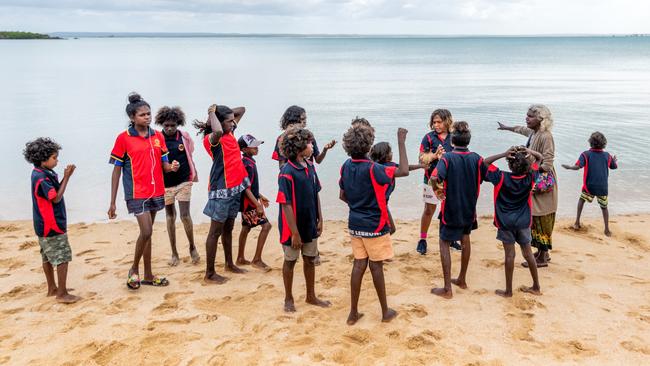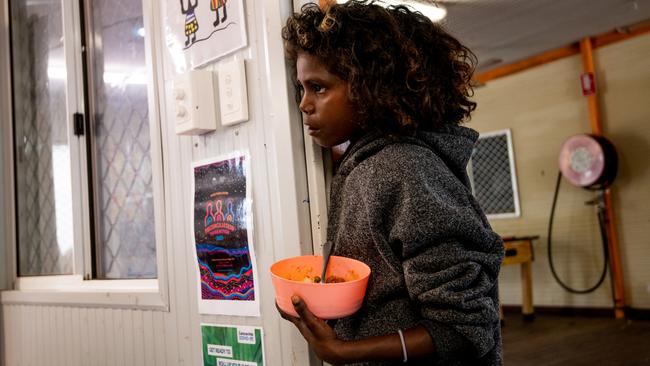Barker College and Yothu Yindi Foundation bridge education gap
What happens when a wealthy private school teams up with the Yothu Yindi Foundation to teach kids in remote Arnhem Land?

A little girl, no more than six or seven years old, wanders into a dusty demountable classroom in one of the most remote parts of northern Australia, looking anxious that she’s arrived so late in the day. The teacher, sitting in a circle on the ground with his students, looks up and his face breaks into a wide grin. “It’s Keira!” he exclaims to the group. “Yay! Great to see you!” He leans over and high-fives her and then applauds. The other kids follow his lead, clap and cheer, and slap their palms on hers as she moves around the circle. Before long, she’s all smiles. “Here, Keira,” the teacher gestures to a place by his side. “And I’ve got your top.” He pulls a polo shirt over her head in the colours of one of Sydney’s most exclusive private independent schools. She sits on the floor, basking in the glow of such a warm welcome.
Later that afternoon, teacher Tom Spencer laughs about the excitement of Keira’s arrival, two hours late. “I’m just so happy to see her coming to school and I need to encourage her to keep coming,” he says. “For these kids, it’s a very big deal. When we started, we had no idea if anyone would come. So it’s about celebrating them when they make the decision to attend.” Keira and the 15 other young indigenous children gathered here in the makeshift classroom in north-east Arnhem Land, a bone-shattering 11-hour dirt road drive east of Darwin, are oblivious to the stark contrast between this scene and the school whose colours they wear, Barker College on Sydney’s wealthy Upper North Shore. They have no idea they’re playing a critical role in an ambitious experiment to “close the gap” in education.

This school, Dhupuma Barker, has been set up as a pioneering partnership between Barker College and the Yothu Yindi Foundation, two groups on opposite banks of the great divide with more than 4000km between them. Their aim? To ensure these kids in the 200-person Yolngu community of Gunyangara, 14km from Nhulunbuy, receive a decent education. Beyond that, they hope their joint venture will provide a template for indigenous education in remote and rural communities.
It’s a tiny school by any standards, with only one classroom where everyone learns together or is divided into smaller groups, either sitting on the floor or on stools gathered around low tables. There’s a single whiteboard at the front of the class, and a section screened off at the back with beanbags and shelves of books on the wall that functions as the library. Individual iPads – a gift from Apple – are handed out for quiet reading times or game-playing. The reception area has tables, pots and pans where meals are served.
Outside, the basketball court is the major attraction, and kids can often still be seen playing there till sundown. For there’s little else for them in this blink-and-you’d-miss-it township with its wide dusty lanes and sprinkling of homes (some of which back directly onto the beach) with washing-draped fences and fridges sometimes on the verandas. One resident claims he has a “pet” saltwater crocodile that he regularly feeds leftovers.

The school’s opening in April this year comes 40 years after Dhupuma College, the original Northern Territory government school in the area, abruptly closed without warning when funds allocated to replace its dilapidated buildings were diverted elsewhere, leaving the community in shock. Later, some graduates of that school set up the award-winning rock band Yothu Yindi, famed for its chart-topping anthem Treaty, and founded The Garma Festival of Traditional Cultures, Australia’s largest annual indigenous gathering. But back home, they wanted their children and grandchildren to have the educational opportunities they’d enjoyed. Instead, their school-age kids were drifting, occasionally attending a school in one of the towns nearby, but more often not. So, three months ago, after many years of planning and searching for a partner, the community opened Dhupuma Barker school. And so far, so good.
“It’s been quite the journey,” says Denise Bowden, CEO of the Yothu Yindi Foundation and director of Garma. “We have a generation of kids who haven’t been getting a good education in numeracy and literacy in a way that could be understood and acknowledged. So this kind of school has been a dream of ours for a very long time. We wanted an independent school to partner with us, away from the government, and we were lucky we found Barker and were able to forge a very respectful relationship.”
A film of a rocket ready to launch lights up the board in the classroom, and Spencer, 36, a Barker teacher who moved here to head up the school, leads the increasingly boisterous countdown to lunchtime. The children, aged between five and 14, stream out into passageway to help themselves to sausage stew and rice. Then they all bolt for the basketball court. In the hot sun they toss basketballs around and right in the middle of the throng is a tall, very white man, catching balls thrown to him, hurling them back. “Mr Heath!” “Mr Heath!” “Mr Heath!” is the constant cry to catch his attention. After 20 minutes, Phillip Heath, head of Barker College, steps off the court to catch his breath. “Isn’t this wonderful?” he gasps. “These children have come such a long way since we opened. It’s brilliant to see their progress.”

The NT wouldn’t be the NT without talk of crocodiles, and these kids are no exception. The next special guest in the classroom, Ranger Stacey Kessner from NT Parks and Wildlife, is warning of the importance of being croc-wise – Baru-aware – in this homeland on the shores of the Arafura Sea. Afterwards, everyone races down the red dust pathway to the beach for a series of maths lessons, drawing in the rough sand with sticks and rearranging shells – just as previous generations had done. At various points, however, kids dart away to wade knee-deep in the sea, forgetting what they’ve just been told. Heath looks pained but two of the four female elders from the community who work with Spencer at the school shout at them to get out. “Sometimes they just don’t listen,” confides Valerie Dhamarrandj, 61, “but they are so much better than they were. Tom is such a good teacher and very patient, and they love him. We’re all so happy to see the kids doing their lessons and enjoying learning. And we are very grateful to Mr Heath.”
For Heath, this all started 17 years ago in Sydney, when he was the head of St Andrew’s Cathedral School and followed, with horror, the riots sparked by the death of a 17-year-old Aboriginal boy in 2004 in Redfern, two train stops away. “It was extremely distressing and I was distressed too that they had almost no impact on St Andrew’s,” he says. “I think detachment wasn’t an option for me. Redfern is the heartland of so much black politics in Australia and there was so much entrenched bitterness around law and order and, somewhat naively, I wanted to do something.”
The next year, Heath attended a school principals’ conference in South Africa and visited a well-to-do independent school in Johannesburg that had set up a series of smaller schools for impoverished children from Soweto, with a focus on achievement and celebrating moments of triumph in literacy and numeracy. “I thought maybe I could do something similar,” Heath says. “The evidence here shows that indigenous children can be up to four years behind other children in literacy and numeracy, which puts them at a huge disadvantage for the rest of their lives.”
In 2007 he set up Gawura, a school within his school, for children from Redfern. The school now caters for Aboriginal children from a wider area and employs 10 indigenous staff. One former student is now studying medicine at the University of Sydney, another is doing her MSc at Oxford University. In 2020 it was voted Australian School of the Year at the Australian Education Awards.
When Heath started at independent Anglican day and boarding school Barker College in 2014, he was keen to extend his vision. While indigenous children were frequently offered day and boarding scholarships at schools, including his, this time he also wanted to establish a school “on country” so younger children could be educated in their own area, in their own culture, in a strong relationship with community elders. “If the Commonwealth is prepared to invest heavily to assist students to board in large independent schools in metropolitan areas,” he asks, “should the government not at least consider the option of empowering local communities to lead local schools?”
Two years later he founded the Darkinjung Barker on the site of a former one-teacher primary school in Yarramalong on the NSW Central Coast, in partnership with the Darkinjung Local Aboriginal Land Council and through philanthropic support and fundraising by parents of Barker Hornsby pupils. For Barker’s head of junior school Martin Lubrano, one of the most touching moments of his career came when a nine-year-old Year 4 boy handed him a note in straggly handwriting: “I luv the school. Please teech me to rite.”
Last year, Heath started another offshoot, Ngarralingayil Barker in the former Wollombi Public School in the Lower Hunter Valley, in partnership with the Kiray Putjung Aboriginal Corporation in Cessnock. Both schools cater for 20 indigenous children from kindergarten to Year 6, when they can choose to continue their education with a scholarship, travelling down to Barker Hornsby, or to move to a local school. “When I first started at Darkinjung Barker, I was two or three years behind in everything,” says Jaiden, 16, who’s now at Barker Hornsby. “I’m a quiet kid so in my other school, no one noticed I wasn’t doing the work. But Barker really helped, and everyone was so supportive and now I’ve caught up to where I’m meant to be. I’m now planning to go to uni for either an arts or business degree.”
While the two new schools have Aboriginal culture and language embedded into all the teaching, learning and playing they do, those values have also become a vital part of the main Barker campus. Non-indigenous students are taught Aboriginal history and culture, and there are regular visits between the three schools to learn from each other, a pen pal system for kids of similar ages, and sports days where they all come together. “There’s a mutuality there between non-indigenous children and indigenous children,” says John Slack-Smith, the chair of Barker’s Foundation Board whose four sons attended Barker. “The benefits flow both ways. The indigenous pillar of Barker College is so exciting for us. The opportunities are not only in terms of indigenous education but also in opening the eyes of the other boys and girls to another culture and giving them the chance to experience other parts of Australia.”
And then, this year, came Heath’s most audacious project yet: opening a third offshoot college in one of the most remote parts of Australia.

It’s 7am and Berry Hetharia is driving a 12-seater minibus around East Arnhem Land to pick up kids for Dhupuma Barker. Some of the students are waiting for him; for others, he knocks on doors or windows to wake them. He has a store of mini KitKats to lure his passengers, and dinner leftovers to keep stray dogs away. Kids on the bus jump out and help round up others. “At first, they didn’t want to come so much,” says Hetharia. “Some of the parents didn’t get an education themselves so they don’t understand what it is, or why it’s important. But now everyone’s much more on board and understand what we’re trying to achieve.”
On the opening day of Dhupuma Barker (Dhupuma is a Yolngu term meaning, “Look up, look beyond”), neither Heath nor Spencer had any idea of what to expect. Then they heard voices and clapsticks in the distance and watched, enthralled, as the community celebrated the school’s arrival with a huge display of singing, dancing and ceremony. It brought tears of joy to Heath’s eyes. “It was a wonderful day,” he says. “It was then that I realised this could really work.”
The venerated figurehead of the community, 1978 Australian of the Year Galarrwuy Yunupingu, gave a welcome speech, then drove around the area for the next two days exhorting any child he came across: “Go to school! Go to school every day!” At the beginning, the attendance rate ranged from 22 to 32 per cent of the 40 or so school-age kids in the area. Now it’s between 80 and 97 per cent. Keira, for instance, hasn’t missed another day of school since that late arrival. Another girl, Whitney, 10, attended only sporadically for the first three weeks of the school’s opening, and even when she came she would often abruptly stand up and walk out. Now, she’s one of the school’s most dedicated pupils, arriving at 7.30 every morning and invariably the last to leave. “She’s making incredible progress,” says Spencer. Amanda, 10, seems to speak for many of her mates. “We like it here,” she says. “Mr Tom is so nice, I call him Father. We’re learning and having fun.”
Not far away, in his home at the end of a dirt road by the old Yothu Yindi recording studio, Yunupingu is also pleased to see how the school is faring. “It’s going well,” he says, nodding. “It’s so important for our children to go to school and they have to be able to stay in their own community, with their own families, while they’re being educated.” The school has a strong commitment to indigenous culture, with lessons run in English and the local tongue, Yolngu Matha, and the Australian curriculum wrapped in Yolngu learning. Spencer has so far learnt 60 Yolngu words but is helped in the classroom by multilingual elders who can interpret for him and his students. The aim is to make the youngsters fluent in both languages.
Breakfast, lunch and a meal before leaving are all supplied, as are the Barker polo shirts, freshly laundered each day. Each child also receives a self-care pack with toothbrushes that frequently double as make-believe microphones for playtime song-and-dance routines. The upper age limit is supposed to be 12 but “no child will ever be turned away”, says Heath. “If they want to be here, we want them to be here.”

The principal has a band of vocal supporters among parents, old boys and philanthropists, and they’ve been joined by even more influential admirers. Leading indigenous advocate Noel Pearson says he loved the idea of Gawura and the schools that Heath established with Barker. “I have been in awe of their progress over the past decade,” he says. “They’ve established an exciting model. It’s one of the best things going on in indigenous education, no two ways about it.
“These partnerships between the country’s most ‘great to excellent’ schools and what we would call ‘poor to fair’ schools are the way of the future,” Pearson says. “Much respect to the Darkinjung and Barker for proving up this model. We have to move on from the 100 per cent public school model for indigenous students. It isn’t working and hasn’t worked in the past. It’s just consigning indigenous students to underachievement. We need to develop partnerships between the best schools in the country – including potentially the best selective public schools – and indigenous communities, to close the achievement gap and stop wasting these precious lives.”

Pearson believes this kind of model needs to be replicated on a large scale and the Federal Government appears, at last, to be paying attention. Education Minister Alan Tudge is also on side. “I think it’s very impressive what Barker has done and I have great admiration for Phillip and his commitment to schools for indigenous students,” he says. “I think it’s a model that could now be replicated and that’s something we’ve been thinking about for some time, in terms of wanting some of our larger, wealthier independent schools to follow their lead and do similar things. This can make a very significant contribution to the future.”
Meanwhile, Heath is sitting on a tiny stool in a circle with the kids in Arnhem Land, giving out his trademark handwritten birthday cards and Freddo Frogs – something he does for all Barker students, wherever they are – to anyone who’s had a birthday in the last few months. He hands out awards and prizes, for writing nicely, for doing sums, for attendance. And then Spencer joins the circle. “Hey, and who’s coming to school tomorrow?” he calls. “Me!” “Me!” “Me!” the kids shout back, doing another round of high fives. “That’s awesome!” says Heath, wreathed in smiles. “Just deadly!”

To join the conversation, please log in. Don't have an account? Register
Join the conversation, you are commenting as Logout